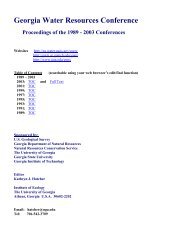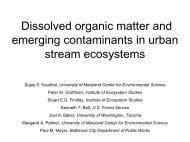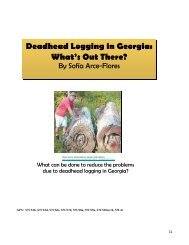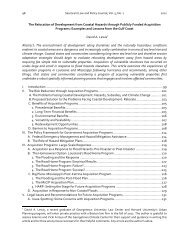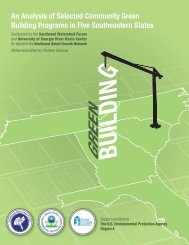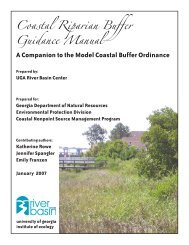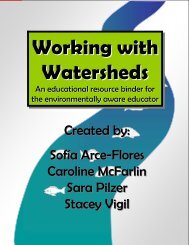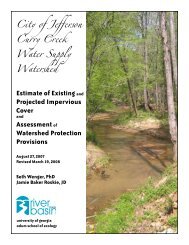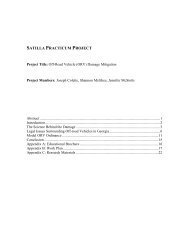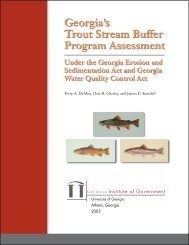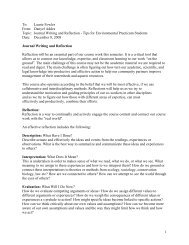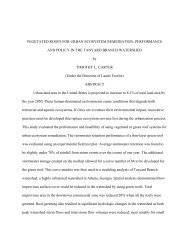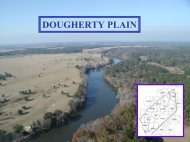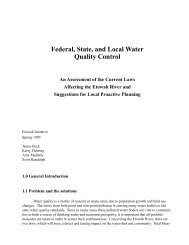1 Bibliographic Review of Sources Relevant to Development of Draft ...
1 Bibliographic Review of Sources Relevant to Development of Draft ...
1 Bibliographic Review of Sources Relevant to Development of Draft ...
You also want an ePaper? Increase the reach of your titles
YUMPU automatically turns print PDFs into web optimized ePapers that Google loves.
Savannah River Annotated Bibliography: January 2003<br />
Christensen, E. (1987). Digital change detection: A quantitative evaluation <strong>of</strong> image<br />
registration and wetland phenological characteristics using high resolution<br />
multispectral scanner data. Columbia, SC.<br />
Christensen, E., J. Jensen, E. Ramsey and H. J. Mackey (1988). "Aircraft MSS data<br />
registration and vegetation classification for wetland change detection."<br />
International Journal <strong>of</strong> Remote Sensing 9(1): 23-38.<br />
Jensen, J., A. Hale and H. J. Mackey (1986). Vegetation stress detection in a southeastern<br />
swamp floodplain using remote sensing and in situ spectral measurements.<br />
Freshwater Wetlands and Wildlife Symposium, Charles<strong>to</strong>n, SC.<br />
Jensen, J., M. Hodgson, E. Christensen, H. Mackey and L. Tinney (1985). Remote<br />
sensing inland wetlands: A multispectral approach. Columbia, SC, South Carolina<br />
Univ., Dep. <strong>of</strong> Geography: 36.<br />
Mackey, H. (1989). Moni<strong>to</strong>ring seasonal and annual wetland changes in a freshwater<br />
marsh with SPOT HRV data, WSRC.<br />
Mathews, N. and K. Dyer (1990). "Floodplain vegetation phenology in the Southeastern<br />
USA: Optimizing the timing <strong>of</strong> aerial imagery acquisition." Wetlands Ecology<br />
and Management 1(2): 65-72.<br />
These studies, performed in the 1980 mostly by EG&G, used multispectral imagery and other<br />
techniques <strong>to</strong> evaluate the extent <strong>of</strong> the thermal disturbance on the SRS Savannah River floodplain<br />
and vegetation recovery. With the exception <strong>of</strong> the Matthews and Dyer study, ground-truthing was<br />
rather minimal, and the vegetation discrimination was limited <strong>to</strong> major types.<br />
Res<strong>to</strong>ration <strong>of</strong> the thermally impacted Pen Branch ecosystem –<br />
a tributary <strong>of</strong> the Savannah River on the SRS<br />
Bar<strong>to</strong>n, C., E. Nelson, R. Kolka, K. McLeod, W. Conner, M. Lakly, D. Martin, J.<br />
Wiggin<strong>to</strong>n, C. Trettin and J. Wisniewski (2000). "Res<strong>to</strong>ration <strong>of</strong> a severely<br />
impacted riparian wetland system- The Pen Branch Project." Ecological<br />
Engineering 15(S): 3-15.<br />
Bowers, C., H. Hanlin, D. J. Guynn, J. McLendon and J. Davis (2000). "Herpet<strong>of</strong>aunal<br />
and vegetational characterization <strong>of</strong> a thermally-impacted stream at the beginning<br />
<strong>of</strong> res<strong>to</strong>ration." Ecological Engineering 15(supplement 1): S101-S114.<br />
Nelson, E., N. Dulohery, R. Kolka and W. J. McKee (2000). "Operational Res<strong>to</strong>ration <strong>of</strong><br />
the Pen Branch bot<strong>to</strong>mland hardwood and swamp wetlands- the research setting."<br />
Ecological Engineering 15(Supplement 1): S23-S33.<br />
Wiggin<strong>to</strong>n, J., B. Lockaby and C. Trettin (2000). "Soil organic matter formation and<br />
sequestration across a forested floodplain chronosequence." Ecological<br />
Engineering 15(Supplement 1): S141-S155.<br />
Pen Branch is one <strong>of</strong> several streams on the SRS that received thermally hot cooling waters from<br />
16



